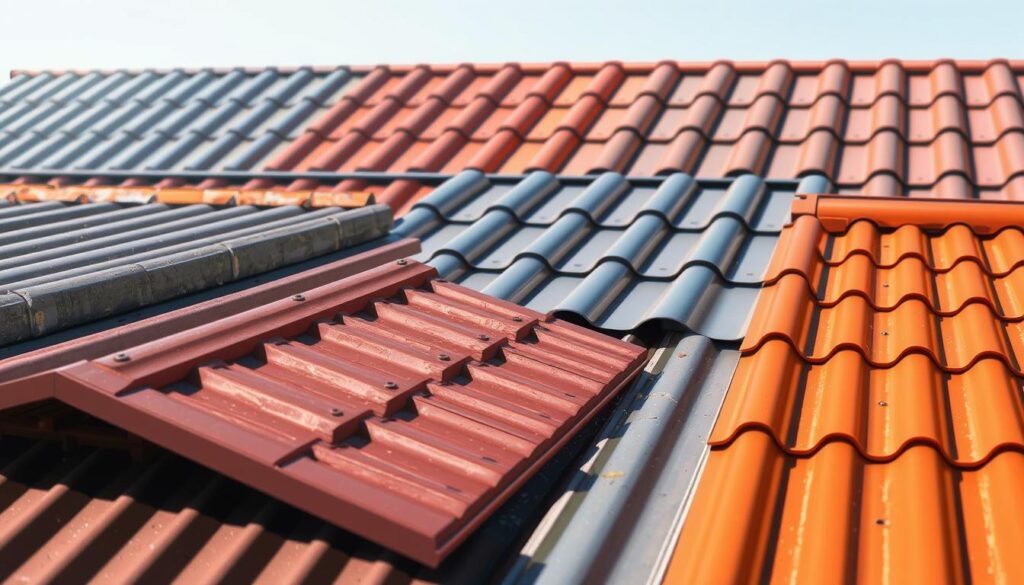Ever wondered why your roof looks different from your neighbor’s? The answer could save you thousands in repairs. Knowing what type of roof do I have isn’t just for contractors—it’s key to avoiding leaks, warranties, and even safety risks. But how do you tell if your roof is aging asphalt shingles or modern metal?
Joyland Roofing’s experts say 70% of homeowners don’t know their roof type. This guide breaks down three easy steps to identify yours: peek at its shape, check old records, or call a pro. From steep-sloped tile roofs to flat commercial styles, your roof’s design affects everything from storm resistance to energy bills.
Key Takeaways
- Roof type determines how often you need inspections and repairs.
- Visual clues like shingle texture or metal panels reveal your roof’s identity.
- Ignoring your roof type can void warranties from brands like GAF or CertainTeed.
- Roof pitch (steep vs. flat) hints at materials like asphalt, metal, or clay tiles.
- Simple steps in this guide work for any home, from suburban houses to modern designs.
Understanding Different Roof Types
Knowing your roof type simplifies roof identification, helping homeowners match maintenance to their structure’s needs. Companies like Joyland Roofing and Colonial Contracting highlight how roof design directly impacts durability and safety. Sloped roofs, for instance, excel in snowy climates, while flat roofs require drainage solutions to avoid pooling water.
The Importance of Roof Type
Roof styles dictate how well a home withstands weather and wear. A steeply sloped roof sheds rain and ice easily, but may need more frequent shingle checks. Flat roofs, common in commercial buildings, demand regular inspections for leaks. Proper roof identification ensures repairs target the right issues. For example, metal roofs resist high winds but need anti-corrosion care.
Common Roof Styles in the U.S.
- Gable Roofs: Classic triangular peaks, often seen in suburban homes.
- Hip Roofs: Sloping sides meeting at a ridge, known for strength in windy areas.
- Flat Roofs: Slightly angled for drainage, common in modern or industrial designs.
- Gambrel Roofs: Dual-sloped like barns, maximizing attic space.
Recognizing these shapes during roof identification guides homeowners toward tailored upkeep strategies. Sloped roofs may need gutter cleaning, while flat roofs require sealant checks. Understanding these basics starts with observing pitch and material.
Key Characteristics of Roofing Materials
Identifying your roof type starts with understanding its materials. Each material has unique traits that stand out when inspecting your roof. Let’s break down three common choices:
Asphalt Shingles
Asphalt shingles are the most common roof types in the U.S. They come in two main styles:
- Three-tab shingles: Thin layers, budget-friendly, but need more frequent replacements
- Architectural shingles: Thicker, layered design with realistic wood or slate patterns
Metal Roofs
Metal roofs combine strength with style. Key features include:
- Standing-seam panels: Sleek, interlocking metal strips for commercial looks
- Corrugated sheets: Wavy patterns suited for barns or modern homes
- Lightweight yet tough: Withstands hail, fire, and extreme temperatures
Tile Roofing
Tile roofs are a durable, long-lasting option:
- Clay tiles: Lightweight, classic Mediterranean or Spanish designs
- Concrete tiles: Heavier than clay but more resistant to cracks
- Fireproof and wind-resistant: Ideal for high-traffic areas
Matching these details to your roof’s look and performance helps narrow down its type. Regular inspections keep these materials in top shape for years to come.
How to Identify Your Roof Type
Figuring out your roof type starts with a mix of observation and research. Joyland Roofing experts recommend starting with three clear steps to avoid guesswork. Let’s break it down:
Step 1: Visual Inspection
Grab a pair of binoculars and look for these clues:
- Material texture: Smooth metal panels, rough asphalt granules, or textured clay tiles
- Ridge style: Boxed, curved, or flat edges
- Color consistency: Weathered areas may expose original roofing materials
Tip: Check valleys and edges where materials often show through better.
Step 2: Check Your Home’s Documentation
Look for these records in your home files:
- Original construction permits
- Installation invoices mentioning roofing materials
- Warranty cards for shingles or tiles
Attic inspections may reveal exposed material edges under eaves or vents.
Step 3: Consult a Roofing Professional
If details remain unclear, pros use specialized tools like moisture meters to assess roofing materials without damaging surfaces. They can also confirm age and condition during the evaluation.
Remember: Misidentifying roofing materials can lead to wrong repair choices. A professional’s trained eye spots details the average eye might miss.
Recognizing Asphalt Shingle Roofs
Asphalt shingles dominate many roof style choices in the U.S. for their affordability and versatility. Traditional three-tab shingles feature a uniform, single layer, while modern architectural styles mimic complex designs like slate or wood. Knowing these differences helps homeowners spot their roof type quickly.
Features of Asphalt Shingles
Look for these clues:
- Granules: Tiny mineral particles on the surface protect against weather.
- Tab patterns: Three-tab shingles have rectangular cuts, while architectural styles have layered edges.
- Age marks: Curling corners or missing granules signal wear.
Lifespan and Maintenance
Most asphalt roofs last 15–30 years.
“Regular inspections catch issues before leaks form,” advises Joyland Roofing.
Check gutters for excess granules—this shows premature aging. Clear debris twice yearly and inspect shingle edges for cracks. Replace damaged tabs promptly to avoid full roof replacement costs.
Identifying Metal Roofs
Identifying roof materials like metal involves recognizing distinct styles and benefits. Metal roofs offer long-lasting options for homeowners seeking durability. Let’s explore how to spot them and why they stand out.

Types of Metal Roofing
Metal roofs come in three main styles:
- Standing seam: Straight lines and panels welded together, popular for modern homes.
- Corrugated: Wavy patterns often seen on barns or commercial buildings.
- Metal tiles: Mimic clay or slate with lightweight aluminum or steel.
Salmon Solutions notes that standing seam roofs are favored for their sleek appearance, while corrugated options are cost-effective for outbuildings.
Benefits of Metal Roofs
Metal offers unique advantages compared to other materials:
- Long lifespan (40-70 years) with warranties from brands like Metal Sales Manufacturing.
- Energy efficiency: Reflective coatings reduce attic heat, lowering cooling costs.
- Fire resistance and wind ratings up to 140 mph, per Joyland Roofing’s technical data.
Homeowners choosing metal often prioritize sustainability—many products are 100% recyclable. Metal’s low maintenance needs make it ideal for busy families. When identifying roof materials, look for consistent panels or seams to confirm metal.
Understanding Tile Roofs
Tile roofs add timeless elegance but require careful upkeep. Clay and concrete tiles each have unique traits that affect durability and maintenance needs. Knowing the difference helps homeowners choose the best fit and maintain their investment properly.
Traditional vs. Concrete Tiles
- Clay Tiles: Made from baked clay, these are lightweight, fire-resistant, and offer classic Spanish or Italian styles. They’re pricier but resist fading.
- Concrete Tiles: Heavier and more affordable, they mimic clay’s look but can crack in freezing temperatures. Ideal for warmer climates.
Tile Roof Care
Maintaining tile roofs involves regular checks to prevent costly repairs. Follow these steps:
- Inspect tiles yearly for cracks, looseness, or algae growth. Use a roof inspection by a pro if you spot issues.
- Clean debris from gutters to avoid water pooling. Pressure washing is risky—brushes or soft sprays work better.
- Seal grout lines every 5–7 years to block moisture infiltration.
While tiles last 50+ years with care, neglect can lead to leaks. Schedule annual roof inspections to catch problems early and extend their lifespan.
Flat Roof Identification
Flat roofs are a modern roof design choice for both commercial and residential buildings. Companies like Joyland Roofing and Colonial Contracting often install these systems using materials like EPDM rubber or TPO membranes. These materials ensure durability in flat roof design, resisting weather and wear over time.
“Regular inspections help maintain the integrity of flat roof designs, preventing costly leaks and damage,” advises Colonial Contracting.
Common Uses for Flat Roofs
Flat roofs are ideal for:
- Commercial buildings like warehouses or offices
- Modern residential homes with minimalist architecture
- Spaces needing rooftop additions like gardens or solar panels
Maintenance Tips for Flat Roofs
To keep flat roofs in top shape:
- Check for water pooling and ensure proper drainage
- Remove debris and check seams for cracks
- Schedule annual inspections by professionals
Popular Roofing Brands in the U.S.
Choosing the right materials for your roof construction requires trust in leading brands. Three names dominate the market for quality and innovation: GAF, CertainTeed, and Owens Corning. These companies offer solutions tailored to different climates and roofing needs.
GAF
GAF leads the industry with its Timberline shingle line. Known for 50-year warranties and energy-efficient options, their products are a staple in residential roof construction. Over 20 million homes use GAF materials, backed by rigorous testing for durability.
CertainTeed
- Offers vinyl roofing with recycled content for eco-conscious builders
- Advanced cooling granules reduce attic heat by up to 30%
- Popular in coastal areas due to saltwater resistance
Owens Corning
Legendary for fiberglass shingles, Owens Corning provides lifetime warranties on some lines. Their Stirlex™ technology ensures color retention and wind resistance up to 130 mph. This makes them ideal for high-wind regions like the Gulf Coast.
When selecting brands, match their strengths to your roof construction goals. Compare warranties, climate ratings, and local installer availability to ensure the best fit for your home’s needs.
Importance of Roof Inspections
Regular inspections keep roofs in top shape. Catching small issues early saves money and avoids major damage. Experts recommend proactive roof maintenance through routine checks.
Frequency of Inspections
Inspect roofs at least twice yearly—spring and fall. Check immediately after severe weather like storms or hail. Homeowners selling their property should schedule an inspection before listing. Professionals suggest adding inspections every 5-7 years for aging roofs.
“Routine inspections are the first line of defense against roof damage.”
What to Expect During an Inspection
Inspectors look for:
- Buckling or curled shingles
- Loose flashing around vents/chimneys
- Pooling water in low areas
- Moss growth on tiles or shingles
They also check attic spaces for leaks or structural damage. Thermal imaging tools may reveal hidden moisture trapped under shingles. Proper roof maintenance plans include documenting findings and prioritizing repairs.
Ignoring inspections risks costly replacements. Small cracks or missing shingles can lead to roof failure within months. A quick annual check costs far less than emergency repairs.
DIY Solutions for Minor Repairs
Minor roof issues don’t always need a pro. But safety comes first! Here’s how to tackle small fixes without risking a fall or causing more damage.
Safety Precautions
- Always use a sturdy ladder with a spotter to hold the base.
- Wear non-slip shoes and a hard hat when working at heights.
- Avoid working in rain, snow, or strong winds.
Common Repairs You Can Do
Try these fixes only if you’re confident and the problem is minor:
- Loose shingles: Replace individual damaged shingles by lifting tabs and sliding in new ones. Match the manufacturer’s guidelines.
- Gutter clogs: Use gloves and a trowel to remove debris. Rinse with a hose afterward.
- Small leaks: Apply roofing cement to cracks in flashings or seams. Use a caulk gun for precision.
“Never climb without a spotter—even for small jobs.” – National Roofing Contractors Association
Always inspect tools before starting. If unsure, pause and call a licensed contractor. Safety gear and common sense are your best allies.
When to Call a Roofing Professional
Knowing when to seek help from a pro is key to protecting your home. Major damage or complex repairs should never be handled alone. Joyland Roofing and Colonial Contracting advise homeowners to act quickly if certain red flags appear.
Signs You Need Expert Help
Watch for these issues: visible sagging, cracked tiles, or curled shingles. Persistent leaks, loose flashing, or pooling water on flat roofs signal deeper problems. Delaying repairs could lead to costly structural damage. Stains on ceilings or mold growth inside the home are urgent warnings.
Questions to Ask a Roofer
Ask contractors about their certifications and local licenses. Request proof of insurance and references. Inquire about warranties for materials and labor. Reputable companies like Colonial Contracting emphasize transparency about repair timelines and cost estimates. Discuss their approach to safety and cleanup during work.



















